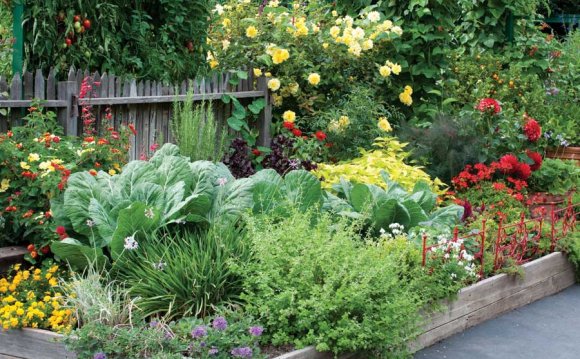

Landscaping with Vegetables
- Get creative with your vegetable garden design. Consider creating a series of decorative raised beds with wood-chip- or gravel-lined paths between. Check out photos of historic French gardens for inspiration - they're beautiful and efficient.
- Plant vegetables with their looks as well as flavors in mind. Alternate, for example, pretty purple cabbage with snowy white cauliflower in a row. Or experiment with planting in blocks and clusters rather than rows for a more decorative effect.
- Many vegetables lend themselves beautifully to containers. Lettuces in various colors are gorgeous in window boxes. Patio-type tomatoes are ideal in large pots. Hot peppers ripen to rich colors that are attractive when mixed in with annual flowers such as marigolds and vinca.
- Tomatoes probably grow better in flower beds than they do in the traditional vegetable garden. That's because they should be moved to a different spot each year to prevent disease, and space is often limited in a vegetable patch. Also, tomatoes do better when isolated from other tomato plants because disease can't hop as easily from plant to plant.
- Lettuces make a great edging plant, especially those that are deep reds and purples. Plant in a row along the front of a bed or border.
- Don't let a little shade deter you from planting vegetables. Fairly shade-tolerant veggies include beets, Brussels sprouts, cabbage, cauliflower, garlic, leaf lettuce, spinach, turnips, radishes, and beans.
- Seek out vegetables in bold colors to interplant among the flowers. Swiss chard, for example, is available in a rainbow of colors. Or try brilliant yellow sweet peppers.
- Pole beans have attractive heart-shape leaves that are fairly decorative. They're good for planting on arbors, along fences, or on any trellis.
- Some mustard greens and kales have gorgeous fall color and are ideal for tucking into containers and borders for color late in the year. Try Osaka Purple mustard greens or one of the red or purple kales.
- Brighten salads with edible flowers. Grow nasturtiums and violas and toss a few petals in with your lettuce for a pretty salad.
See vegetable garden plans.
Grow veggies in raised beds.
Landscaping with Fruit Trees and Shrubs
- If you don't have room for full-size fruit trees, check out the new miniatures and dwarfs now available. Some grow just 4 or 5 feet tall and are perfect for growing in large pots or whiskey barrels.
- Rhubarb is so pretty it's a shame to relegate it to the vegetable garden. Tuck it into the flower bed or border. It's especially nice underplanted with purple-leaved Ajuga or another low-growing groundcover.
- Strawberries make an excellent edging plant as well as a good groundcover. Plant them in long rows, one or two plants deep, along the edges of flower beds and borders. Or use them on a sunny slope or any other area where you want a pretty groundcover. They cover themselves with white flowers in spring, and the leaves turn a rich russet in fall.
- Blueberry and currant bushes are pretty enough to use as decorative shrubs. Plant a whole hedge of them to assure plenty of fruit.
- Grapevines are beautiful plants. Try growing two of them up over an arbor. When you're not harvesting grapes, you can use the leaves, either green or tinged by autumn color, to decoratively line plates and platters. Top with salads or cheeses.
- Raspberries are expensive to buy at the supermarket, but a snap to grow at home. If you're concerned about having too many all at once, plant the ever-bearing types, which will produce from midsummer to frost. Also, they do well in light to medium shade, so you can plant them in an out-of-the-way corner of the yard.
- Try growing short vining-type vegetables up trellises along the back of a flower border.
 Melons, cucumbers, and zucchini can all be trained to grow vertically; this means fewer fungal disease problems.
Melons, cucumbers, and zucchini can all be trained to grow vertically; this means fewer fungal disease problems.
Grow a potted fruit tree.
Landscaping with Herbs
- Rosemary is among the most decorative of herbs. It's often available in cleverly shaped topiary. Grow it in pots or plant directly in the ground.
- Herbs that once were plain green now are available in many different colors and variations that make them an excellent foliage plant to use in beds and borders, as well as containers. 'Purple Ruffles' basil and 'Tricolor' sage are two outstanding examples.
- Chives are not only good snipped into salads and over potatoes, they also have nice green foliage and pretty, pink, ball-like flowers. They are especially effective when planted in rows as an edging.
- Thyme is one of the best groundcovers for hot, sunny, dry areas. It forms a dense mat and flowers in the spring. It's perfect for planting in among pavers or flagstones and is fragrant when stepped upon.
- Other herbs deserve more use as a groundcover. Oregano spreads readily, as does prostrate rosemary and chamomile.
- While it's tempting to put all your herbs together in one bed, they do nicely when mixed in among flowers. The glossy green leaves of parsley and coriander, for example, are a simple foil to most flowers.
- Herbs are also good mixed in with flowers in indoor arrangements. Basil, tarragon, sage, chives, and many others are all perfectly suited for interior living.
Source: www.bhg.com















